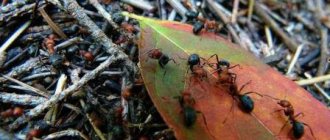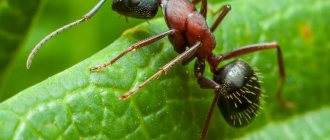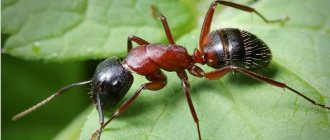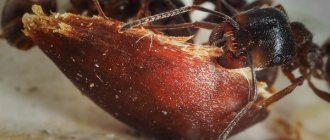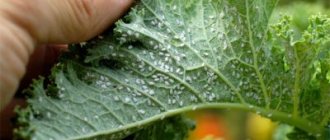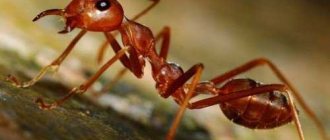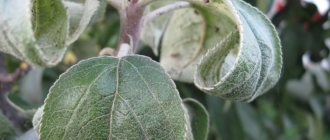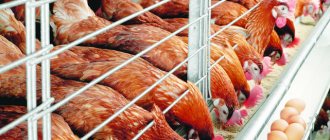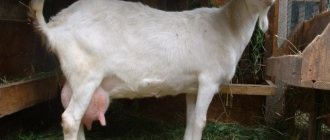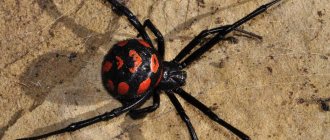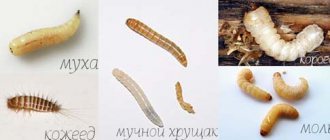Private houses and city apartments are increasingly becoming habitats for ants. They come to human habitation in search of an inexhaustible source of food and warmth. The presence of such a place allows insects not to think about wintering, not to hibernate during cold weather, and to always have food.
Optimal living conditions for ants are high humidity and a temperature of about 20°C -30°C. For food, they prefer to consume sweet drinks, crumbs from flour products, cereals, fruits and other dishes that are publicly available in the apartment.
The house can be favored by red, black and yellow ants. If one or more single individuals are found in an apartment, you should immediately take measures to destroy them. The peculiarities of their lifestyle, physiology and reproduction complicate the process of fighting insects. For the process to be effective and to obtain the expected result, you need to know how to find the queen of a colony, clusters of individuals and a nest of ants in an apartment. This is usually a hard-to-reach, dark, warm and damp place in the kitchen, bathroom or bathroom. You should carefully inspect the openings in the walls for sockets and switches, the space between the tiles and under the baseboard, cracks and holes in the wooden floor.
Often the nest is located not in the apartment itself, but between floors. If the ant population has become large enough, they begin to expand their habitat into neighboring rooms. Specialized teams equipped with professional equipment will help destroy insects in interfloor ceilings.
Helpful advice
Passive observation is often the most effective way to detect insects in an apartment. Study the direction where insects take food. If they go into holes, then silicone sealant will help cut off their path to the food source.
Ants in the apartment: how to find a nest
If the fight against ants was successful, you should study the reasons that lead to the appearance of these insects. Information is necessary to prevent recurrence of unpleasant events. A high risk of ants appears in private country houses with unfavorable sanitary conditions. The colonization of insects is facilitated by a large amount of garbage, food in the public domain, crumbs and spilled drinks on the table, and unwashed dishes. In city apartments, ants often appear as a result of migration from neighboring rooms, garbage chutes, attics, basements and interfloor ceilings.
What to do if there are ants in the apartment, how to find the nest? In this case, it is necessary to identify the queen of insects. It is not enough to destroy other inhabitants of the nest, as the population will quickly recover. Passive observation is the main way to detect the habitat of a colony. Ants choose secluded and hard-to-reach places with high humidity and comfortable temperatures. These can be ventilation holes, cracks in the floor and walls, baseboards, and various cavities.
Experienced insect exterminators will help you quickly find an ant nest. Using professional equipment, they are able to examine and treat hard-to-reach places in the house, attics, basements and interfloor spaces.
Where live
Reaper ants
Speaking about where the reapers live, experts note dry areas of steppes and deserts. For this species, the optimal conditions are minimal precipitation and a relatively warm climate. Reapers are incredibly thrifty, so the ant house is always filled with food warehouses. They will eat up the reserves in the winter, when there are no grain crops left in the fields.
Taking care of reapers is quite simple. Feed is purchased in specialized stores. You cannot use crops that are intended to be sown in fields. If an ant manages to eat such food, it may become poisoned. Before planting, producers treat all crops with protective chemicals that are dangerous for ants.
Caring for harvester ants includes the following indicators:
- Selection of food.
- Lighting.
- Air temperature.
- Humidity.
- Place of detention.
Under natural conditions, reapers can live both in anthills above and below the ground. The choice of location depends on external climatic conditions.
What does an ant queen look like?
The main rule for effective ant control is to find and destroy the queen. This is the progenitor of the colony, which is able to quickly restore the population size if the workers die. In a couple of weeks, the number of insects can increase several times.
An ant colony is distinguished by a strict hierarchy, headed by the queen. Its main function is to organize the survival and growth of the population. It does not carry out work functions, does not obtain food, does not provide shelter, and does not protect the place from other insects. All other worker ants work for the benefit of its interests and ensure periodic replenishment of the colony with new residents.
To detect the progenitor of a population, you need to know what the queen looks like and how it differs from other ants. The following signs will help with this:
- body size is 2 times larger than that of working individuals;
- length up to 5 mm;
- brown chitinous shell;
- dark and round abdomen with light thin stripes up to 4 mm in size;
- low mobility;
- massiveness;
- developed and wide chest.
This structure of the ant uterus arises due to the initial presence of wings. Fertilized females that establish an anthill independently gnaw them off or discard them. The large abdomen is intended for laying eggs. Increasing the number of colonies is the main function of the uterus. Over the course of her life, she can lay up to 500 thousand eggs.
Fishing Features
It is important not to damage the insect or injure it during fishing, otherwise nothing will work
. After stress, the queen can simply die, and if her thinnest waist is damaged, this will also lead to death.
In the wild, queens are caught by scientific myrmecologists or professional keepers - holders of ants, who can determine the time and place of the search, as well as correctly catch them and create all the conditions necessary for brood.
Important:
In no case should insects caught on the street be planted in an existing farm - this can introduce mites or pathogens into the formicarium, which will lead to the death of the insects. But the children who are caught will still not be accepted; they will be killed or made slaves.
It's not enough to just catch a couple of ants on the street to start forming an ant farm.
. With a high degree of probability, these will be simple workers or scouts who are not able to reproduce; most likely they will die within a few days. It is best to purchase a ready-made farm, along with an incubator tube, inside of which there will be a queen ant and a small amount of brood.
How to find the queen ant in an apartment
One colony of ants can organize several nests around the house and have several main individuals. The only way to get rid of insects is to find and destroy all the queens. To estimate the scale of the disaster, you can multiply the number of detected individuals by ten. This is a method that allows you to approximately understand the number of ants living in the house.
How to find the queen ant in an apartment? Studying the following features of their lifestyle will help with this:
- To house the queen, worker ants choose warm and dark places. It is necessary to carefully inspect ventilation openings and hard-to-reach places in the kitchen, bathroom and toilet.
- Pay special attention to cupboards with cereals and areas near food products.
- Passive observation will help determine the location of the uterus. Look where the workers take the food they get.
- Ant nests can often be found on balconies, attics and basements of multi-storey buildings.
Carefully!
When fighting domestic cockroaches on your own, you should remember that killing worker ants will not bring the desired result. The queen quickly restores the size of the colony.
External structure
Ants are insects that are considered one of the most famous and numerous in the world.
Ant size and weight vary depending on the species. Body length can range from 1 to 50 mm. And more often than not, the largest ants are also the most dangerous in the world. Moreover, females are usually much larger than males. Body color depends on the species. The anatomy of an ant is quite complex. The body of the murash is covered with a chitinous shell. This kind of skeleton not only supports, but also protects the baby. The description of the appearance of different representatives is almost similar. Head, chest and abdomen - this is the structure of the ant. A photo of the ant can be seen below.
Ant close up
Head
The head of an ant is usually large in size; for each individual species it differs in a certain structure. It has powerful mandibles. With them, workers carry food, blades of grass and twigs used for building nests. Mandibles also help insects defend themselves.
Eyes
Not everyone can answer the question of how many eyes an ant has. The insect's eyes have a complex faceted structure. In addition to the paired ones, there are 3 more ocelli. With them, tiny creatures determine the level of illumination and the plane of polarization of the light flux.
Mouth
The mouthparts of an ant are of the gnawing type. It includes the jaws, which are also called mandibles or mandibles, the upper lip (labrum) and the lower lip (labium). The mandibles can be large or not very large, excessively sharp or completely blunt. They are also overlapping and interlocking. Thanks to this feature of ants, mandibles can chew food even with their mouths closed.
The organ of taste for goosebumps is the tongue located on the lower lip. Insects also use it to clean their bodies.
Mustache
The sensory organ of insects is the geniculate antennae. They help ants detect odors, detect vibrations and vibrations in the air. In addition, insects use this organ to receive and transmit signals during communication with their relatives.
Abdomen
The abdomen of ants is stalk-shaped (the stalk is formed by one or two rings). There may be a vertical growth or notches on it. Some varieties of ants have a sting at the end of their abdomen, which serves as a tool for hunting and their defense. Thanks to it, insects secrete acid - a special substance that paralyzes the enemy.
Paws
The ant has 3 pairs of well-developed legs, each of which is located on a separate thoracic segment and ends in a hooked claw. Thanks to this feature, the ant’s movements can occur not only on horizontal, but also on vertical surfaces. A close-up photo of the ant is shown below.
Ant body
The method of their movement depends on the structural features of the insects' paws. Not all ants move on foot; some species have the ability to jump. There are also gliding insects and runner ants, red fire ants are able to form bridges over water barriers.
The ant's legs serve more than just movement. So, with its front legs, equipped with special brushes, the insect takes care of its antennae. Spurs located on the hind legs are used for attack and defense. And the presence of small serrations on all legs allows insects to move even along steep, smooth surfaces. An example of this is pharaoh ants, which can run quickly on glass.
How to deal with ants in an apartment
All methods of fighting ants can be divided into several categories:
- folk remedies;
- ultrasonic repellers;
- mechanical traps;
- chemicals.
Folk remedies are represented by various aromatic herbs and spices. They are not highly effective in pest control. Traditional methods are suitable as deterrent measures that reduce the likelihood of ants reappearing. For this, plants with a strong aroma are used - mint, lavender, wormwood, tansy.
The most popular and effective methods of killing insects is the use of chemicals. On the market you can find a variety of gels, crayons, aerosols, powders, traps with glue and poisonous baits.
Flight table
Now you are ready to go queen hunting! But there is one problem - each type of ant flies only at a certain time of the year, some species fly twice a year. How can we understand when the species we are interested in will fly? For this we can use the flight table. It shows approximately what time a particular species flies. You need to understand that the table shows deadlines, and this does not mean that your species will fly at that particular time.
Massive flight of the leafcutter Acromyrmex versicolor
Reaper ant (Messor constructor) – what kind of animal?
According to scientific classification (taken from Wikipedia):
- Kingdom: Animals
- Type: Arthropods
- Class: Insects
- Order: Hymenoptera
- Family: Ants
- Subfamily: Myrmicines
- Genus: Reaper Ants
- Species: Steppe Reaper Ant
- Latin name Messor structor
(Latreille, 1798)
Ants are granivorous, small and medium in size. They live mainly in regions with an arid climate (i.e. dry, desert with large daily temperature fluctuations). This circumstance is pleasing, because means that there is no need to carefully maintain the temperature regime for them.
Grains for food are collected on the ground and stored in special chambers of the anthill. Periodically take out to dry.
They are eaten after being crushed into porridge by the mandibles of soldier ants.
They form monogynous families (i.e., consisting of one oviparous individual and many servants in the form of workers and soldiers) numbering about 5,000 individuals.
There is no clear division between workers and soldiers, because... there are many transitional forms.
Vertical ant farms
The main advantage of this design is that the arena is quite large, which means that the insects will have enough space to eat and walk. An example is the “Cube” ant farm. At the same time, you can observe the life of ants both from the side and from above. The advantages include:
- Compact in size, such a farm will be conveniently located even in a small room.
- The spacious arena can accommodate more decorative items.
- It is easy to install additional blocks or trusses.
Life cycle
Ants go through four stages of development:
- Egg.
- Larva.
- Pupa (sometimes a cocoon, called metamorphosis depending on the species).
- Adult.
The larvae do not have legs, but they can make minor movements, such as tilting their heads towards a food source when feeding. At this stage, the level of care and nutrition that the larvae receive determines their eventual adult form. When resources are limited, all larvae will develop into female worker ants.
However, if the colony has an adequate supply of food, some larvae receive better nutrition than others and develop into winged ones. Sexually mature female ants are destined to leave the anthill. At this stage, female winged ants are sometimes called “princess ants.”
Preparation
Before you go on a search, you need to prepare several test tubes that will become the basis of a future colony.
You need to pour a little water inside, then form a tight lump of cotton wool and close this water tightly - it will gradually saturate the cotton wool and serve as a nutrient medium for the colony during its primary growth.
It is also necessary to have cotton swabs with you, with the help of which you can guide the uterus inside the test tube as carefully and delicately as possible. There is no ready-made recipe for how to catch a queen ant.
, the main thing is to be as careful as possible and try not to injure her.
Remember!
Queens with wings have not yet been fertilized, so they are not of interest as future queens.
There is no need to feed the caught insects, and you can move them into the formicarium once the colony inside the test tube reaches at least 50 individuals.
Notes
- Dlussky G. M.
Ants of the genus Formica / Ed. K. V. Arnoldi. - M.: Nauka, 1967. - 236 p. — 2300 copies. - Peeters C., B. Hölldobler.
Reproductive cooperation between queens and their mated workers: The complex life history of an ant with a valuable nest // Proceedings of the National Academy of Sciences. - 1995. - T. 92. - P. 10977–10979. - ↑ 12345
Life of animals. Arthropods: trilobites, chelicerates, trachea-breathers. Onychophora / Ed. Gilyarova M. S., Pravdina F. N. - 2nd, revised. - M.: Education, 1984. - T. 3. - 463 p. - Orphan army ants adopted (The queens of African Dorylus army ants measure 5 centimeters)
- Heinze, Jürgen (1995). “Ant reproductive strategies” (PDF). Res. Popul. Ecol. 37
(2): 135–149. DOI:10.1007/BF02515814. - Himler, Anna G. (2009). "No sex in fungus-farming ants or their crops." Proc. R. Soc. B 276
(1667): 2611. DOI:10.1098/rspb.2009.0313. PMID 19369264. - V. Ya. Stanek.
Illustrated encyclopedia of insects. - Prague: Artia, 1977. - P. 262. - 560 p. - Franks NR, Resh VH, Cardé RT (eds).
Encyclopedia of Insects. - San Diego, 2003. - P. 29-32. — ISBN 0125869908. - Keller L.
Queen lifespan and colony characteristics in ants and termites (English) // Insectes Sociaux: Journal. - 1998. - Vol. 45. - P. 235-246. — DOI:10.1007/s000400050084. - Hölldobler, Wilson, 1990, pp. 143-179.
